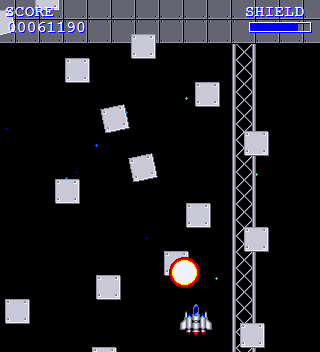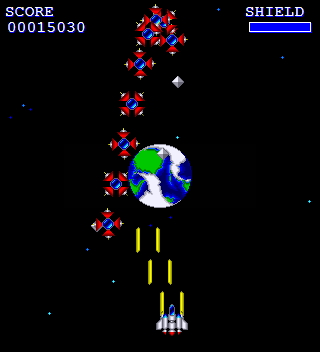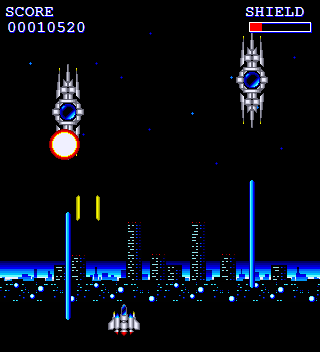Official Site || Vector Download Page
Blast Force is a one-button game to an unusually literal degree and it pulls off this minimalistic control scheme remarkably well. Attacking, charging your laser, moving, and even choosing to use a continue are all tied to a single button. This is a short game even by shmup standards, but its polished and creatively unique gameplay make it a great game to play and go back to.
There are a lot of one-button games out there, but nearly all of them either tie the button to a single action, such as jumping in an endless runner, or apply the term somewhat loosely by not counting buttons used for movement. Blast Force takes things to a more literal extreme by treating your entire keyboard, including the Escape key, as a single button used for absolutely everything. To be clear, I’m not stating that this more literal and experimental take on one-button gameplay is inherently better, but it is impressive to see how it all works. So, just how does it work? Your ship is positioned at the bottom of the screen and it is incapable of vertical movement, but it automatically moves left when you aren’t pressing a button and holding down a button will make it move right. In other words, the ship is never stationary unless it is pressing against the left or right side of the screen. In addition to making the ship move to the right, pressing a button will fire a burst of yellow projectiles in front of the ship and holding down a button will charge a laser which is fired when you release the button and it homes in on and bounces between targets while moving upward. Thus, your available choices at any given time can be boiled down to three actions; you can touch nothing to move to the left without attacking, you can rapidly tap a button to remain relatively stationary while shooting a focused stream of weaker projectiles, or you can hold down a button to drift right and let go to release a strong homing laser.

The control scheme here is strangely restrictive and it can take some time to get used to, but the game does a phenomenal job of building itself around these restrictions. The challenge which first sold me on the controls was the asteroid field segment in the second stage. In this part there are several columns of small asteroids drifting to the left and the player must wait for an opening in which they can safely pass through. You only need to pay attention to a specific point in the asteroid column due to the lack of vertical movement, but by this same token you only get a very limited opportunity during which to avoid this obstacle. Furthermore, the way in which this obstacle is approached is much more active in nature due to the way movement works as you must repeatedly yet carefully tap a button to remain close enough to the column to be able to dash through in time when the opportunity presents itself and, rather than taking a moment to relax as the next column approaches, you must immediately start to tap a button once more to prevent your ship from moving left and crashing into the asteroids you just avoided. While other shmups provide a challenge through demanding pixel-perfect dodging like in a bullet hell or attack you from multiple directions with combinations of enemies and environmental hazards like in Gradius, Blast Force challenges players by presenting them with fairly simplistic obstacles which need to be approached in new ways. Even entirely common threats such as enemy ships flying downward from both sides of the screen must be confronted with a different mindset because the fact that you need to steadily move right in order to charge the homing laser means that the right side of the screen getting blocked off by enemies or obstacles is inherently more debilitating than the left side becoming blocked.

If there is one way in which Blast Force closely resembles many other great shmups, it is how its boss fights clearly show off its biggest strengths. The first boss is actually one of my favorites as it consists of two pillar-like ships which move back and forth across the screen. They spend most of the fight shooting down streams of long lasers which scroll with them, which gives players the opportunity to approach this fight in two very different ways. You can play it safe and charge up a laser when neither boss is near the right side of the screen in order to deal a decent amount of damage to each boss or you can take a more risky approach by staying near one of the bosses and barraging it with normal shots to quickly destroy it even though the laser is more difficult to dodge with this approach. Other bosses pose unique challenges by taking advantage of the limited movement system, such as by firing off a long string of bullets aimed at your ship which will trap you if you move to either of the edges too quickly, and by making you use your weapons in new ways, such as through employing a shield which can only be temporarily shoved away with a laser while you attack the main body with normal shots. Like with the stages themselves, bosses are simplistic without being trivial and each fight serves as a new puzzle.

There is a pleasant balance to the level of difficulty found in the five stages of Blast Force. The game starts out somewhat difficult and there is a gradual bump up in difficulty with each new stage, with a notable increase in difficulty in the final two stages in particular, though even then never to a ridiculous degree. You need to start at the beginning of the current stage when you die, but stages are kept fairly short and the entire game can be completed in roughly 15 minutes without retries. You only get a single life and don’t have any screen-clearing bombs, but your ship is surprisingly durable and is capable of taking six hits before it explodes, though you only get a split second of invincibility between hits so they can add up quickly. This is a fairly easy game to finish, but it’s just challenging enough that you’ll feel satisfied upon reaching the end.
Sound is the only point where the simplistic style of Blast Force works against it. Specifically, there are some good sound effects but no music over the course of the game other than during the ending. Some games can get away with only using crisp sound effects, but here there is just enough downtime that the silence becomes a bit too noticeable.

Blast Force is outright brilliant in its simplicity. While many games end up feeling bland because they focus too strongly on the one-button control scheme in and of itself, Blast Force has carefully crafted an entire experience around its dedication to simplicity and the end result is wonderfully memorable.